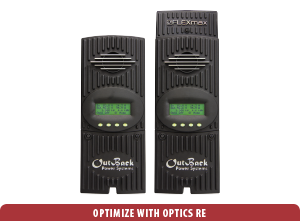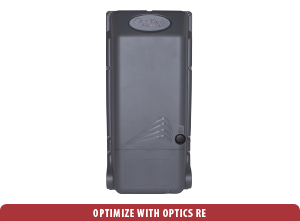High End Solar Charge Control Systems
MPPT (Maximum Point Power Tracking) charge controllers are output amperage limited and input voltage tolerant. They use a method to try to match the input power with the output power using all of the potential power generated by the panels. Higher the voltage of the array and higher the battery bank voltage will allow more controller capacity. The Outback FLEXmax 60, FLEXmax 80, and FLEXmax 100 AFCI have an output current capability of 60, 80 and 100 Amps respectively. The input open-circuit voltage tolerance is 150VDC for the 60 and 80Amp versions and 300VDC for the 100Amp version. Three different scenarios might look like this:


12V battery, FLEXmax 60
Maximum Input Voltage = 150VDC. This means that with a typical 350W class panel with a Voc of 48V that up to 3 panels could be connected in series for a Voc of 144VDC.
Maximum Theoretical input Power = 3 panels x 350W/panel = 1050W.
Maximum Output Power = 12V x 60A = 720W.
In this case the output power will be limited by the battery voltage. The solar panels are overbuilt, which is not a bad this in this situation because they will produce the maximum 720W output even in lower light conditions such as dusk and dawn or shorter winter days.
24V battery, FLEXmax 80
Maximum Input Voltage = 150VDC. This means that with a typical 350W class panel with a Voc of 48V that up to 3 panels could be connected in series for a Voc of 144VDC.
Maximum Theoretical input Power = 3 panels x 350W/panel = 1050W.
Maximum Output Power = 24V x 80A = 1920W.
In this case the output power will be limited by the solar array. The solar panels are underbuilt because they are in a 3S1P (3Series, 1Parallel) configuration. To get maximum power a 3S2P configuration should be used. The input voltage remains at 144VDC, but the Maximum Theoretical input Power is now: 6 panels x 350W/panel = 2100W.
48V battery, FLEXmax 100
Maximum Input Voltage = 300VDC. This means that with a typical 350W class panel with a Voc of 48V that up to 6 panels could be connected in series for a Voc of 288VDC.
Maximum Theoretical input Power = 6 panels x 350W/panel = 2100W.
Maximum Output Power = 48V x 100A = 4800W.
In this case the output power will be limited by the solar array. The solar panels are underbuilt because they are in a 6S1P (6Series, 1Parallel) configuration. To get maximum power a 6S2P configuration should be used. The input voltage remains at 288VDC, but the Maximum Theoretical input Power is now: 12 panels x 350W/panel = 4200W. The system could also be configured with a 5S3P configuration for an input voltage of 240V, total panel power of 5250W, and total output power of 4800W.
Other Configurations
If you have a large system that needs more energy, 80 amp charge controllers can be "stacked" or combined to provide more charge amperage. Each controller needs its own array based on the above limits. As many as 10 controllers can be used to charge the same large battery bank.
This is more cost effective and has the benefit of redundancy compared to the few very large charge controllers that can handle up to 300 Amps from a single array. 300 Amps using multiple 80 amp controllers will cost less than $4,800. The largest charge controller we know about costs over $15,000. If the $15,000 controller goes down you are out of business. If one of the 80 amp controllers goes down, you still have 75% of your charge capability.
The best way to handle larger solar arrays being used to charge a big battery bank is to refine your array wiring to maximize the array voltage and minimize the array amps.
For example, 18 each 350 Watt 72 cell modules wired three modules in series and 6 strings parallel will result in an array maximum power voltage of about 91 volts and about 36 amps. I have seen my own arrays generate as many as 112 volts, usually on partly cloudy days where the "edge of cloud effect" increases the intensity of sunlight. Solar panels increase in efficiency the colder they get. If you are in an always warm climate you may be able to wire 4 panels in series, saving wire and circuit breakers or fuses.
The handy table below shows the maximum capability of the Outback charge controllers based on output current and battery voltage.
| Manufacturer Part Number | Description | Max Input Voltage | Max Power 12VDC | Max Power 24VDC | Max Power 48VDC |
| FM60-150VDC | OutBack 60 A MPPT charge control | 150 | 750.0 | 1500.0 | 3000.0 |
| FM80-150VDC | OutBack 80 A MPPT charge control | 150 | 1000.0 | 2000.0 | 4000.0 |
| FM100-300VDC-AFCI | OutBack 100 A MPPT charge control w/ AFCI | 300 | 0.0 | 3500.0 | 7000.0 |
Midnite Solar Classic 150 MPPT and Midnite Solar Classic 200 MPPT have an input voltage of 150VDC and 200VDC respectively. The handy table below shows the maximum capability of these charge controllers based on output current and battery voltage.
| Manufacturer Part Number | Description | Max Power 12VDC | Max Power 24VDC | Max Power 48VDC | Max Input Voltage |
| CLASSIC 150 | Full version | 1379.0 | 2701.0 | 4770.0 | 150 |
| CLASSIC 200 | Full version | 1106.0 | 2126.0 | 4023.0 | 200 |
| CLASSIC 150-SL | SL version | 1379.0 | 2701.0 | 4770.0 | 150 |
| CLASSIC 200-SL | SL version | 1106.0 | 2126.0 | 4023.0 | 200 |
Morningstar has a similar line of 150 volt 60 amp Tristar MPPT charge controller which will allow configurations below.
| Manufacturer Part Number | Description | Max Power 12VDC | Max Power 24VDC | Max Power 48VDC |
| TS-MPPT-30 | TriStar MPPT 30 A charge controller | 440.0 | 880.0 | 1760.0 |
| TS-MPPT-45 | TriStar MPPT 45 A charge controller | 650.0 | 1300.0 | 2600.0 |
| TS-MPPT-60 | TriStar MPPT 60 A charge controller | 875.0 | 1750.0 | 3500.0 |
| TS-MPPT-60M | TriStar MPPT 60 A charge controller with meter display | 647.0 | 1294.0 | 2588.0 |
Morningstar has recently introduced a 600 volt 60 amp Tristar MPPT charge controller which will allow 12 to 15 each 250 watt 60 cell modules to be wired in series in one string, saving array wiring expense and combiner and circuit breaker or array fuse expense. The charge controllers are 48V only as it is very difficult and inefficient to output sufficient current to 24V or 12V batteries with high input voltage and high powered arrays.
| Manufacturer Part Number | Description | Length | Width | Height | Weight |
| TS-MPPT-60-600V-48 | TriStar 60 A/600 VDC 48 V MPPT charge controller | 18.0 | 10.0 | 7.0 | 22.0 |
| TS-MPPT-60-600V-48-DB | TriStar 60 A/600 VDC 48 V MPPT charge controller with DC disconnect | 24.0 | 10.0 | 7.0 | 30.0 |
| TS-MPPT-60-600V-48-DB-TR | TriStar 60 A/600 VDC 48 V MPPT charge controller with DC disconnect and transfer switch | 24.0 | 13.0 | 11.0 | 29.0 |
| TS-MPPT-60-600V-48-DB-TR-GFPD | TriStar 60 A/600 VDC 48 V MPPT charge controller with DC disconnect and transfer switch and GFPD | 39.0 | 13.0 | 11.0 | 40.0 |